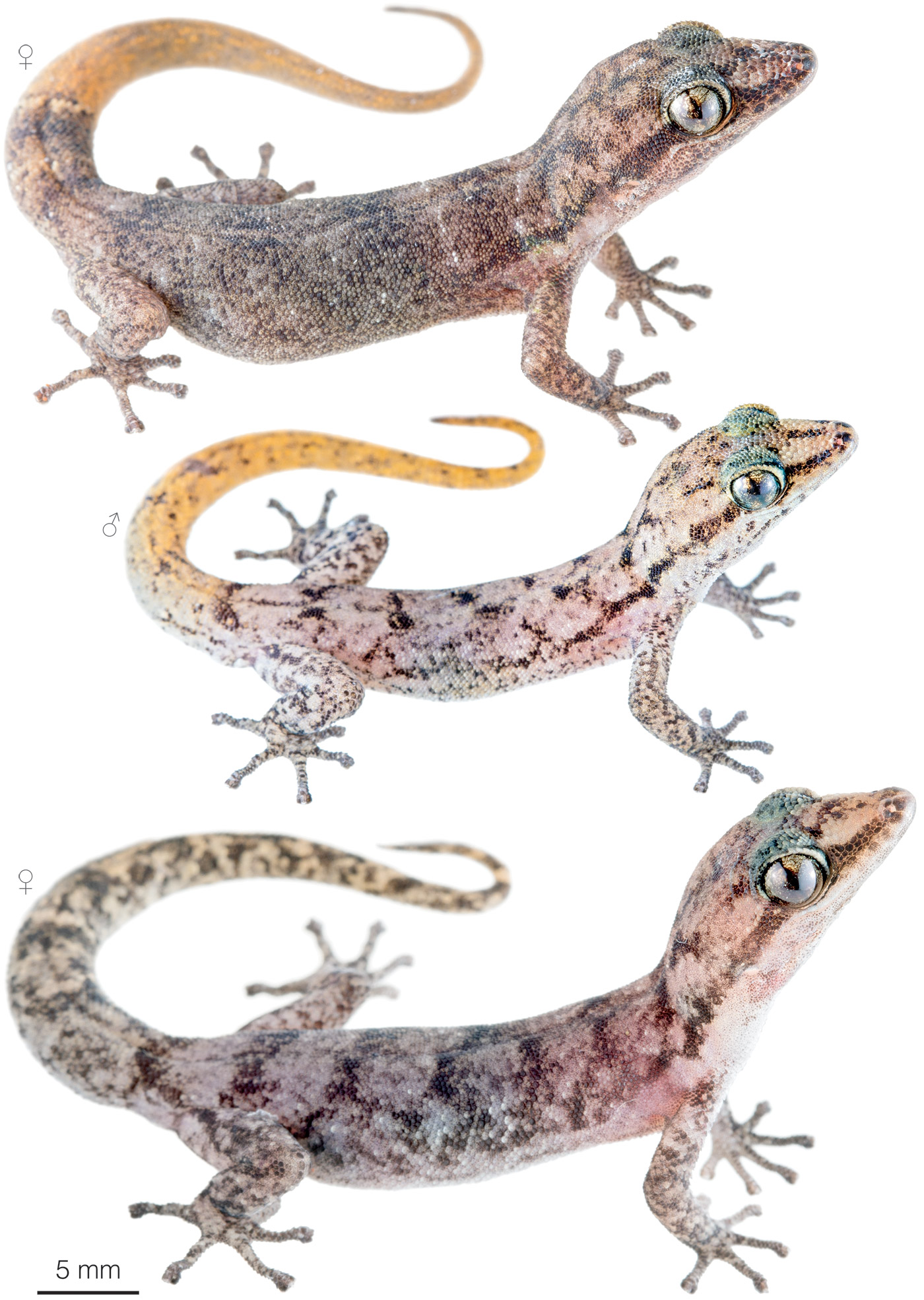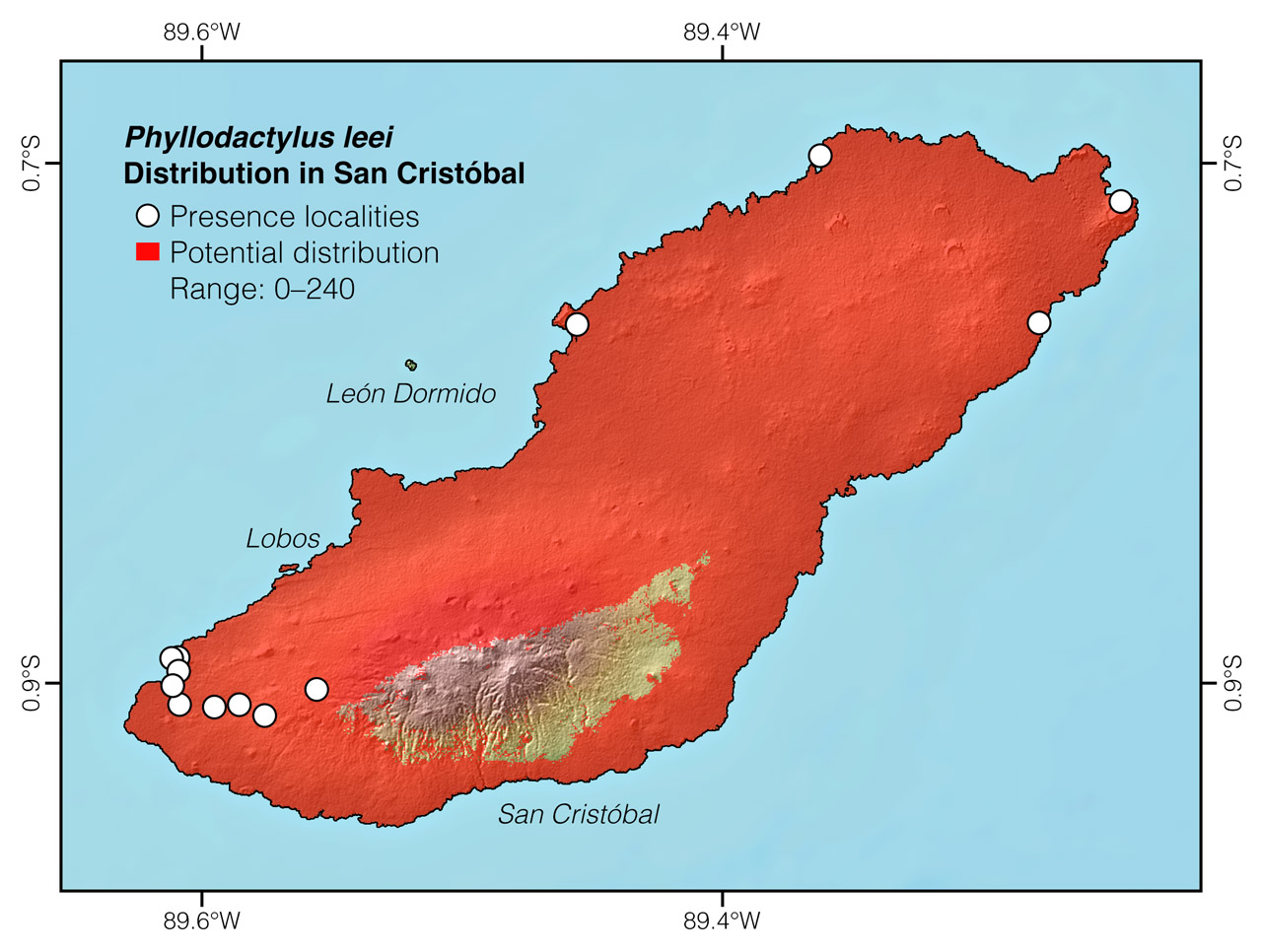Published October 10, 2019. Updated December 27, 2023. Open access. Peer-reviewed. | Purchase book ❯ |
San Cristóbal Leaf-toed Gecko (Phyllodactylus leei)
Reptiles of Ecuador | Sauria | Phyllodactylidae | Phyllodactylus leei
English common name: San Cristóbal Leaf-toed Gecko.
Spanish common names: Geco de San Cristóbal, salamanquesa de San Cristóbal.
Recognition: ♂♂ 7.7 cmMaximum distance from the snout to the tip of the tail. ♀♀ 8.6 cmMaximum distance from the snout to the tip of the tail..1 Geckos in general are easily distinguishable from other lizards by their nocturnal habits and vertical pupils. Phyllodactylus leei is one of six (two native, four introduced) geckos occurring on San Cristóbal Island. Among these, it is the only one having rounded digital disks and a dorsum lacking large protruding tubercles (Fig. 1). The most similar co-occurring geckos are P. darwini and P. reissii, but these are larger in body size and have bulging dorsal scales.1

Figure 1: Individuals of Phyllodactylus leei from Puerto Baquerizo Moreno, Galápagos, Ecuador. j=juvenile.
Natural history: Phyllodactylus leei is a nocturnal and mostly terrestrial gecko that is most common in rocky outcrops and vegetation up to 0.5 m above the ground in dry shrubland areas, but also occupies walls and concrete surfaces in human settlements.1–3 During daytime, San Cristóbal Leaf-toed Geckos seek refuge under stones and lava blocks, within crevices, and beneath the bark of trees.3 In most of these microhabitats, this species lives side by side with P. darwini. When threatened, individuals of P. leei wiggle their tails as a decoy to potential predators; under an attack, an individual may shed its tail as well as emit high-pitched sounds.1 There are recorded instances of predation on this species, including by snakes (Pseudalsophis eibli) and by housecats.1 The eggs of P. leei are laid under lava blocks.2
Conservation: Near Threatened Not currently at risk of extinction, but requires some level of management to maintain healthy populations..3 Phyllodactylus leei is listed in this category because the species is facing the threat of displacement by introduced geckos in areas (currently only urban) where the latter have become invasive4 as well as predation by housecats,2 and, therefore, may qualify for a threatened category in the near future if these threats are not addressed. However, there is no current information on the population trend of the San Cristóbal Leaf-toed Gecko to determine whether its numbers are declining.
Distribution: Phyllodactylus leei is endemic to an area of approximately 496 km2 in San Cristóbal Island, Galápagos, Ecuador (Figs 2, 3).

Figure 2: Distribution of Phyllodactylus leei in Galápagos. See Appendix 1 for a complete list of the presence localities included in the map.

Figure 3: Distribution of Phyllodactylus leei in San Cristóbal Island. See Appendix 1 for a complete list of the presence localities included in the map.
Etymology: The generic name Phyllodactylus comes from the Greek words phyllon (=leaf) and daktylos (=finger),5 and refers to the leaf-shaped fingers characteristic of this group of geckos. The specific epithet leei honors Prof. Leslie Lee, the naturalist of the expedition that led to the discovery of P. leei.6
See it in the wild: Individuals of Phyllodactylus leei can be seen year-round with almost complete certainty on the outskirts of Puerto Baquerizo Moreno, especially along the trail leading from the town to Playa Punta Carola. The ideal search time is just after sunset, when the geckos are actively foraging on rocky surfaces.
Authors: Alejandro ArteagaaAffiliation: Fundación Khamai, Reserva Arlequín, Ecoruta Paseo del Quinde km 56, Santa Rosa de Mindo, Pichincha 171202, Ecuador. and Gabriela AguiarbIndependent researcher, Quito, Ecuador.
Academic reviewer: Cruz MárquezcAffiliation: University of Rome Tor Vergata, Rome, Italy.
Photographer: Jose VieiradAffiliation: Tropical Herping (TH), Quito, Ecuador.,eAffiliation: ExSitu, Quito, Ecuador.
How to cite? Arteaga A, Aguiar G (2023) San Cristóbal Leaf-toed Gecko (Phyllodactylus leei). In: Arteaga A, Bustamante L, Vieira J (Eds) Reptiles of Ecuador: Life in the middle of the world. Available from: www.reptilesofecuador.com. DOI: 10.47051/XHYO7944
Literature cited:
- Arteaga A, Bustamante L, Vieira J, Tapia W, Guayasamin JM (2019) Reptiles of the Galápagos: life on the Enchanted Islands. Tropical Herping, Quito, 208 pp. DOI: 10.47051/AQJU7348
- Van Denburgh J (1912) Expedition of the California Academy of Sciences to the Galápagos Islands, 1905-1906. VI. The geckos of the Galápagos Archipelago. Proceedings of the California Academy of Sciences 1: 405–430.
- Cisneros-Heredia DF, Márquez C (2016) Phyllodactylus leei. The IUCN Red List of threatened species. Available from: www.iucnredlist.org. DOI: 10.2305/IUCN.UK.2016-1.RLTS.T178276A56282962.en
- Olmedo J, Cayot L (1994) Introduced geckos in the towns of Santa Cruz, San Cristóbal and Isabela. Noticias de Galápagos 53: 7–12.
- Brown RW (1956) Composition of scientific words. Smithsonian Books, Washington, 882 pp.
- Cope ED (1889) Scientific results of explorations by the U.S. Fish Commission steamer Albatros. III. Report on the batrachians and reptiles collected in 1887–88. Proceeding of the United States National Museum 12: 141–147.
Appendix 1: Locality data used to create the distribution map of Phyllodactylus leei in Ecuador (Fig. 2). Go to the section on symbols and abbreviations for a list of acronyms used.
| Country | Province | Locality | Source |
| Ecuador | Galápagos | Bahía Sardina | iNaturalist; photo examined |
| Ecuador | Galápagos | El Progreso | Olmedo & Cayot 1994 |
| Ecuador | Galápagos | Finger Point | Arteaga et al. 2019 |
| Ecuador | Galápagos | Mirador Tijeretas | Arteaga et al. 2019 |
| Ecuador | Galápagos | Puerto Baquerizo Moreno | Arteaga et al. 2019 |
| Ecuador | Galápagos | Punta Carola | Arteaga et al. 2019 |
| Ecuador | Galápagos | Punta Pitt | Arteaga et al. 2019 |
| Ecuador | Galápagos | Punta Pitt, 6 km SW of | iNaturalist; photo examined |
| Ecuador | Galápagos | Road to the settlement | Arteaga et al. 2019 |
| Ecuador | Galápagos | Unnamed Road | Arteaga et al. 2019 |
| Ecuador | Galápagos | USFQ station | Arteaga et al. 2019 |
| Ecuador | Galápagos | Wreck Bay | Van Denburgh 1912 |
| Ecuador | Galápagos | Wreck bay, 1 km E of | Arteaga et al. 2019 |